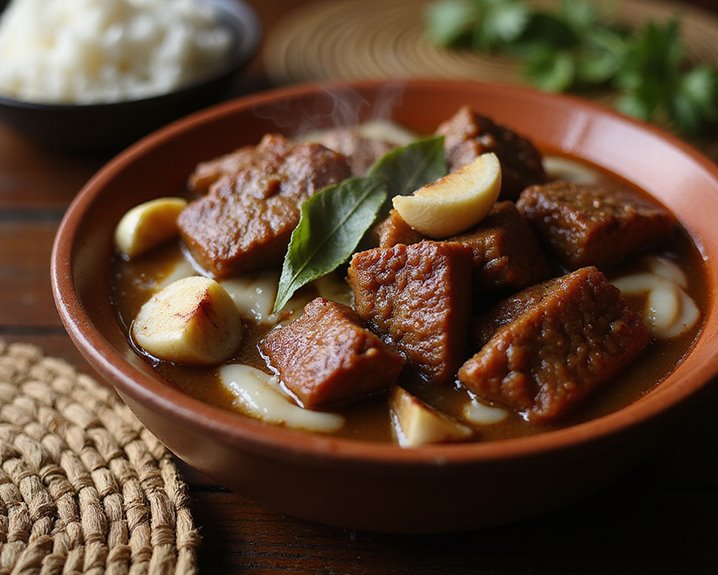Why You’ll Love this Filipino Pork Adobo With Coconut
I’m head over heels for this Filipino Pork Adobo with coconut milk, and I bet you’ll be too. This dish brings together the perfect balance of tangy vinegar, savory soy sauce, and rich coconut milk in one comforting pot.
The tender cubes of pork soak up all that incredible flavor, while a whole head of smashed garlic infuses the sauce with aromatic goodness. Can you imagine that fragrance filling your kitchen? Divine.
What makes this version special is the addition of coconut milk, which mellows the acidity and creates a silky, luxurious sauce that’s absolutely perfect for spooning over steaming rice. The optional Thai chile adds just enough heat to keep things interesting, without overwhelming your taste buds.
What Ingredients are in Filipino Pork Adobo With Coconut?
Filipino Pork Adobo with coconut milk offers a delicious twist on the classic national dish of the Philippines. This hearty, savory dish combines tender pork with a rich, tangy sauce that’s both comforting and complex.
The addition of coconut milk creates a silkier, slightly sweeter sauce that balances beautifully with the traditional vinegar and soy sauce base. Let’s look at what goes into making this mouthwatering variation.
- 3 tablespoons canola oil
- 2½ pounds pork, cubed (boneless country ribs work well)
- ½ teaspoon salt
- ½ teaspoon pepper
- 2 cups vinegar (apple cider, sherry, or Filipino white vinegar)
- 1 cup soy sauce
- 1 (14 ounce) can chicken stock
- 1 (14 ounce) can coconut milk
- 1 whole head of garlic, peeled and smashed
- 3 bay leaves
- 1 Thai bird chile
When shopping for these ingredients, a few considerations might make your adobo even better. The recipe notes that this can be a bit salty, so you might want to use low-sodium soy sauce if you’re watching your salt intake. And yes, you really do need a whole head of garlic—don’t skimp!
The Thai bird chile adds a nice heat, but you can adjust according to your spice preference by keeping it whole for milder heat or slicing it and removing seeds for a medium kick. Or add more chiles if you’re feeling brave! The recipe intentionally makes plenty of sauce, which is perfect for spooning over a bed of steaming rice.
How to Make this Filipino Pork Adobo With Coconut

To make this delicious Filipino Pork Adobo with Coconut, start by heating 3 tablespoons of canola oil in a large saucepan over medium-high heat until it’s very hot but not smoking. While the oil heats, season 2½ pounds of cubed pork (boneless country ribs work perfectly) with ½ teaspoon salt and ½ teaspoon pepper. Brown the meat in batches if needed, making sure each piece gets a beautiful caramelized crust. This step builds incredible flavor, so don’t rush it—those browned bits are culinary gold.
Once your pork is nicely browned, add 2 cups of vinegar (apple cider, sherry, or Filipino white vinegar all work well), 1 cup of soy sauce (consider low-sodium if you’re watching salt intake), a 14-ounce can of chicken stock, and a 14-ounce can of coconut milk. The coconut milk is what makes this version special, adding a subtle sweetness and creamy texture to balance the tangy vinegar.
Toss in a whole head of peeled and smashed garlic (yes, the entire head!), 3 bay leaves, and 1 Thai bird chile. You can leave the chile whole for milder heat or slice it down the middle and remove seeds for a more controlled spice level. Want it spicier? Just add another chile or two.
Let everything simmer together until the pork becomes tender and the sauce reduces and concentrates in flavor. For authentic results, consider using a traditional Filipino wok cooking set to achieve the perfect heat distribution and flavor development. This recipe intentionally makes plenty of sauce—perfect for spooning over a big mound of steaming white rice. The combination of tangy vinegar, savory soy, rich coconut milk, and tender pork creates a harmony of flavors that’s absolutely worth the wait. And don’t those aromatics smell amazing as they bubble away? There’s nothing quite like the scent of adobo filling your kitchen.
Filipino Pork Adobo With Coconut Substitutions and Variations
While the classic recipe creates a mouthwatering dish, there’s plenty of room to play with this Filipino favorite and make it your own. If you don’t have canola oil, any neutral cooking oil works perfectly fine. Can’t find Thai bird chile? Substitute with serrano or even red pepper flakes to control the heat level.
For a leaner version, try chicken thighs instead of pork—they absorb the flavors beautifully. Vegetarians might appreciate using firm tofu or meaty mushrooms like portobello or king oyster.
The vinegar is essential, but feel free to experiment. Rice vinegar creates a milder tang, while apple cider adds subtle sweetness. Want it creamier? Add a bit more coconut milk. Less saucy? Reduce the stock slightly. The beauty of adobo is its flexibility, honestly.
What to Serve with Filipino Pork Adobo With Coconut
Tradition dictates that no proper Filipino pork adobo is complete without its perfect accompaniments. I can’t stress enough how important steamed white rice is as the foundation—it soaks up that rich, tangy coconut sauce beautifully.
For a crisp contrast, try a simple side of quick-pickled vegetables or cucumber salad with vinegar and a touch of sugar.
Green veggies like sautéed bok choy or string beans balance the richness, while fried plantains offer a sweet counterpoint to the savory pork. Want something more substantial? Garlic fried rice (sinangag) elevates the meal to weekend-worthy status.
Don’t forget a small dish of sliced bird’s eye chilies in vinegar on the side—it’s perfect for those who want to add an extra kick to each bite.
Final Thoughts
As I’ve shared this coconut-infused pork adobo recipe with you, I’m reminded why this dish holds such a special place in Filipino cuisine. The marriage of tangy vinegar, savory soy sauce, and rich coconut milk creates a harmony of flavors that’s simply irresistible.
The abundant sauce is intentional, perfect for spooning over steaming rice. You might find yourself reaching for bread to soak up every last drop, too. Trust me, your family will be asking for this dish again and again. Who can blame them?
What makes this version special is the generous amount of garlic—yes, a whole head—and that hint of heat from the Thai bird chile. Isn’t it amazing how these simple ingredients transform humble pork into something extraordinary?

